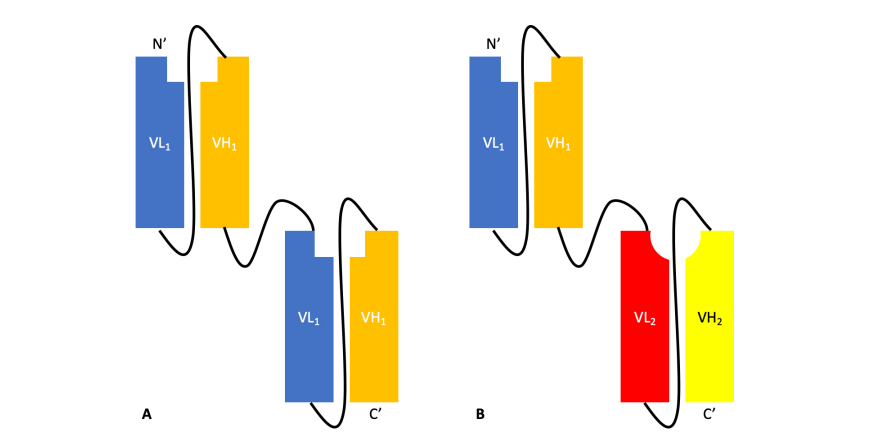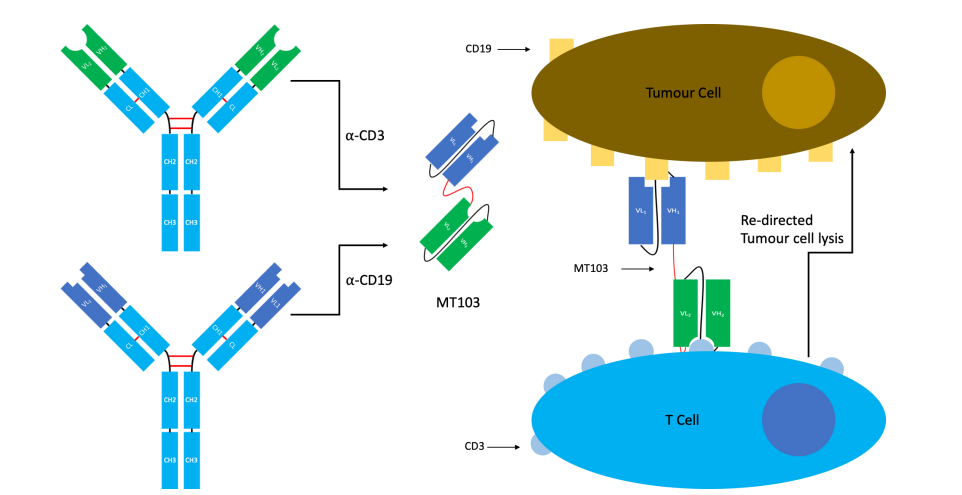A tandem scFv links two or more scFvs with the helical peptide linkers in the orientation NH2–VL1–VH1–(linker–VL2–VH2)n–COOH, resulting in a single chain bivalent and bi-specific molecule encoded by a single gene (Figure 2). Tandem scFv can be used to target two different antigens on two different cells, two different antigens on the same cell, or two different epitopes on the same antigen with increased avidity.

Figure 2. The tandem scFv platform. (A) A monospecific bivalent tandem scFv composed of two identical scFvs joined by a helical linker. (B) A bispecific bivalent scFv composed of two different scFvs joined by a helical linker (adopted from: Bates A, Power CA. (2019) David vs. Goliath: The Structure, Function, and Clinical Prospects of Antibody Fragments. Antibodies, 8:28).
Bispecific T-cell engagers (BiTE) are a type of tandem scFv used to redirect cytotoxic T-cells to tumors. The induced response is highly selective against the target tumor cells (Figure 3). It contains two antigen binding sites. The first is focused towards a tumor antigen, whereas the second is focused towards the T-cell receptor (TCR) signaling complex CD3. Simultaneous binding of the BiTE to CD3 and the tumor antigen evades pMHC restriction and encourage T-cell activation and cytokine production towards the tumor-directed cytotoxic response, and the activation of other host immune responses. Bispecific T-cell engagers has been used to treat the non-Hodgkin’s lymphoma and Philadelphia chromosome negative acute lymphoblastic. In addition, Bispecific killer cell engagers (BiKEs) and trispecific killer cell engagers (TriKEs) are bi- or trispecific tandem scFvs has been developed to redirect natural killer (NK) cells via an anti-CD16 scFv.
 Figure 3. The structure and mechanism of action of MT103, an α-CD3/α-CD19 bispecific T-cell engager (BiTE). The antigen binding site of each parental antibody is isolated and converted into an scFv format. The two scFvs are then joined by a flexible peptide linker to produce a bispecific moiety. The anti-CD19 scFv binds to tumour cells whilst the anti-CD3 scFv will bind passing T-cells, re-directing them to attack the tumour cell (adopted from Bates A, Power CA. (2019) David vs. Goliath: The Structure, Function, and Clinical Prospects of Antibody Fragments. Antibodies, 8:28).
Figure 3. The structure and mechanism of action of MT103, an α-CD3/α-CD19 bispecific T-cell engager (BiTE). The antigen binding site of each parental antibody is isolated and converted into an scFv format. The two scFvs are then joined by a flexible peptide linker to produce a bispecific moiety. The anti-CD19 scFv binds to tumour cells whilst the anti-CD3 scFv will bind passing T-cells, re-directing them to attack the tumour cell (adopted from Bates A, Power CA. (2019) David vs. Goliath: The Structure, Function, and Clinical Prospects of Antibody Fragments. Antibodies, 8:28).
Formats of bispecific antibodies (BsAbs)
Many formats have been developed for BsAb generation as listed in the following table.


